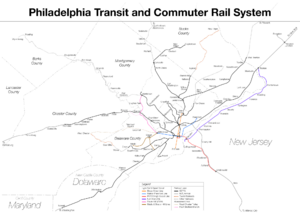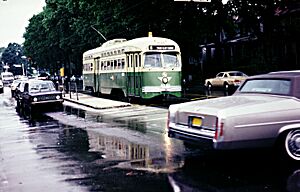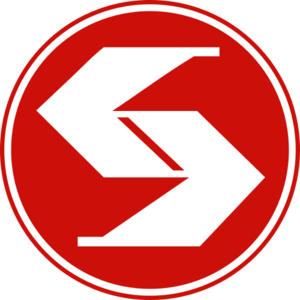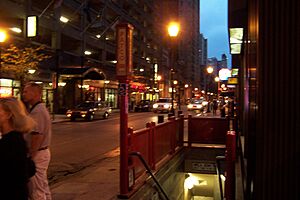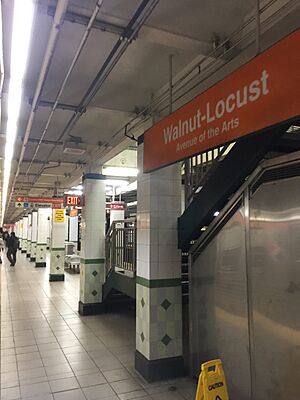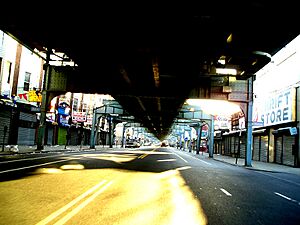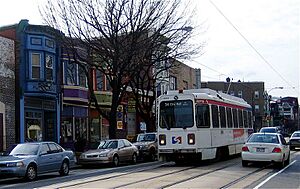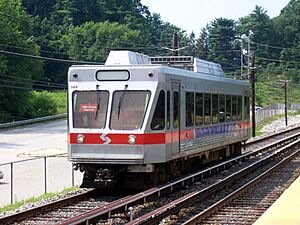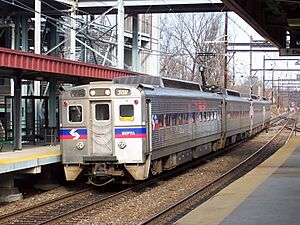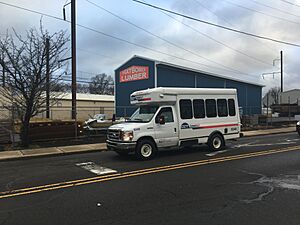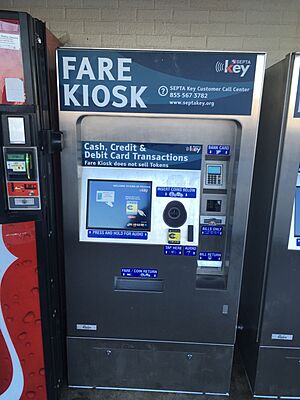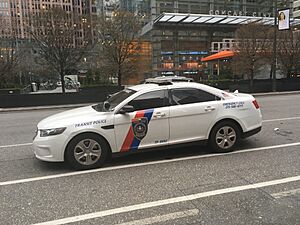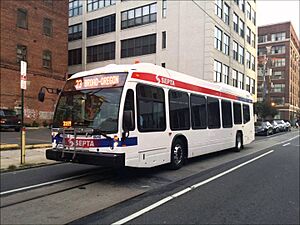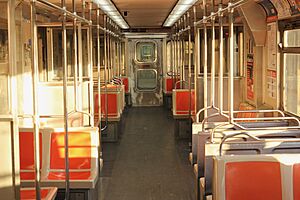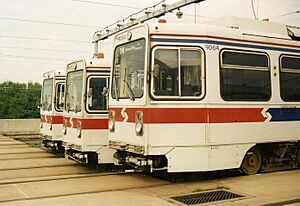SEPTA facts for kids
Quick facts for kids Southeastern Pennsylvania Transportation Authority (SEPTA) |
|||
|---|---|---|---|
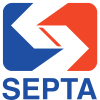 |
|||
| Info | |||
| Locale | Delaware Valley | ||
| Transit type |
|
||
| Number of lines | 196 | ||
| Number of stations | 290 | ||
| Chief executive | Scott Sauer (General Manager) | ||
| Headquarters | 1234 Market Street, Philadelphia, Pennsylvania, U.S. | ||
| Website | septa.org | ||
| Operation | |||
| Began operation | November 1, 1965 | ||
| Number of vehicles | 2,897 (2018) | ||
|
|||
SEPTA, which stands for the Southeastern Pennsylvania Transportation Authority, is a big public transportation system. It helps almost four million people travel around Philadelphia and its nearby areas in Pennsylvania. SEPTA runs different types of vehicles like buses, subway trains, commuter trains, light rail trolleys, and electric trolleybuses. It also works on keeping its stations, tracks, and vehicles in good shape.
SEPTA is the main way people travel in Philadelphia and the four counties around it: Delaware, Montgomery, Bucks, and Chester. It's a special organization created by the state. Most of its leaders are chosen by the counties it serves. Some SEPTA trains and buses also go to parts of Delaware and New Jersey. SEPTA is one of the largest transit systems in the United States. It has 290 active stations, over 450 miles (724 km) of track, and 196 different routes.
SEPTA is special because it's the only transit system in the U.S. that uses all five main types of land-based public transportation. These are regional commuter trains, subway and elevated trains, light rail trolleys, trolleybuses, and regular buses.
Contents
History
How SEPTA Started
SEPTA was created on August 17, 1963, by the Pennsylvania government. Its goal was to help organize money for different train and transit companies in southeastern Pennsylvania. SEPTA officially started running on February 18, 1964.
On November 1, 1965, SEPTA took over two older groups. One group, the Passenger Service Improvement Corporation, helped improve commuter train service. The other, the Southeastern Pennsylvania Transportation Compact, worked to coordinate transportation in the region.
By 1966, SEPTA was managing the commuter train lines of the Reading Company and Pennsylvania Railroad. Later, in 1983, SEPTA took over these train operations completely. It bought the tracks, trains, and other equipment to create its own Railroad Division.
Growing the System
On September 30, 1968, SEPTA bought the Philadelphia Transportation Company (PTC). This company ran buses, trolleys, and subway lines across the city. This became SEPTA's City Transit Division.
Later, on January 30, 1970, SEPTA bought the Philadelphia Suburban Transportation Company, also known as the Red Arrow Lines. This added the Norristown High Speed Line, the Media–Sharon Hill Line, and several suburban bus routes. Today, this is called the Victory Division.
SEPTA also took over other bus services, like the Schuylkill Valley Lines, in 1976. Over time, SEPTA worked to combine the different train services. There have been ideas to bring back train service to places like Allentown and West Chester.
More recently, SEPTA has been planning to make its system easier to understand. In September 2021, SEPTA suggested renaming its subway and trolley lines as "SEPTA Metro." This plan includes new maps and signs to help people find their way. For example, the Market–Frankford Line might be called "the L" and colored blue. SEPTA is working to roll out these changes.
How SEPTA is Managed
SEPTA is run by a board of 15 directors. These directors are chosen by different groups.
- The City of Philadelphia chooses two members. These two members can stop a decision made by the board if they think it's not good for the city.
- Bucks, Chester, Delaware, and Montgomery counties each choose two members.
- Leaders from the Pennsylvania State Legislature (Senate and House of Representatives) choose four members in total.
- The Governor of Pennsylvania chooses one member.
The people who manage SEPTA day-to-day are led by the general manager. This person is hired by the board of directors. The current general manager is Scott Sauer.
How Many People Ride SEPTA
In 2020, people took 223.5 million rides on SEPTA. This included rides on city buses, subways, and regional trains.
Ridership went down between 2014 and 2019. SEPTA said this was due to more competition and lower gas prices. The big drop in ridership from 2019 to 2020 was mainly because of the COVID-19 pandemic. Many people stayed home during that time.
SEPTA Routes
SEPTA has three main types of services: the Metro, bus routes, and regional rail lines.
Metro
SEPTA's city train services, including subways, trolleys, and interurban lines, are part of SEPTA Metro. SEPTA has the largest trolley system in the United States.
| Line | Type | Service | Termini | |
|---|---|---|---|---|
| South/West | North/East | |||
| Rapid transit | 69th Street Transit Center | Frankford Transit Center | ||
| Rapid transit | NRG Station | Fern Rock Transit Center | ||
| Walnut–Locust NRG Station (Sports Express) |
||||
| 8th–Market | Olney Transit Center (Weekday) Fern Rock Transit Center (Saturday) |
|||
| Trolley | 63rd–Malvern/Overbrook | 13th Street | ||
| 61st–Baltimore/Angora | ||||
| Yeadon Darby Transit Center (Limited) |
||||
| Darby Transit Center | ||||
| 80th Street/Eastwick 73rd–Elmwood (Current Termni) |
||||
| Trolley | 63rd–Girard | Richmond–Westmoreland or Frankford–Delaware |
||
| Light rail | Orange Street/Media | 69th Street Transit Center | ||
| Chester Pike/Sharon Hill | ||||
| Light metro | 69th Street Transit Center | Norristown Transit Center | ||
Buses
SEPTA has 115 bus routes, mostly in Philadelphia. Some routes use numbers like 1-99 for city lines. Routes in the 100s are for suburban areas. Routes in the 200s connect to regional rail.
Trolleybuses
Trolleybuses, also called trackless trolleys by SEPTA, run on routes 59, 66, and 75. These buses get their power from overhead electric lines. Service on these routes started again in 2008 after being stopped for a few years. SEPTA bought new low-floor trolleybuses to replace older ones.
Regional Rail
On January 1, 1983, SEPTA took over the commuter train services. It organized them into the Regional Rail system. This system has 13 lines that serve over 150 stations. These lines cover most of southeastern Pennsylvania. They also go to Wilmington and Newark in Delaware, and Trenton and West Trenton in New Jersey.
Most of the trains used on these lines were built between 1976 and 2013. Newer Silverliner V trains were added starting in 2010. These new trains helped replace older ones. In 2016, many Silverliner V trains had to be repaired due to cracks. This caused some delays and fewer trains running for a while.
How SEPTA Operates
SEPTA has three main operating groups: City Transit, Suburban, and Regional Rail. These groups reflect the different types of transportation SEPTA has taken over. SEPTA also offers a special service called Access for people with disabilities.
City Transit Division
The City Transit Division runs routes mostly within Philadelphia. This includes buses, subway-surface trolleys, one surface trolley line, the Market–Frankford Line, and the Broad Street Line. Some city routes also go into Delaware, Montgomery, and Bucks counties. This division came from the old Philadelphia Transportation Company.
Suburban Division
Victory District
The Victory District runs suburban buses and trolley/rail routes. These routes are based at the 69th Street Transportation Center in Upper Darby. Its rail lines include the Norristown High Speed Line (Route 100) and the Media–Sharon Hill Line (Routes 101 and 102). This district used to be called the Red Arrow Lines.
Frontier District
The Frontier District runs suburban bus routes based at the Norristown Transportation Center. It also has bus lines that serve eastern Bucks County.
Suburban Contract Operations
Some bus lines are run by other companies under contract with SEPTA. For example, Krapf Transit operates Route 204 in Chester County. These companies help SEPTA provide service in certain areas.
Railroad Division
The Railroad Division operates 13 commuter train routes. These routes start in Center City Philadelphia and go outwards to suburbs and even other states.
This division came from the old commuter lines of the Reading Company and the Pennsylvania Railroad. In 1984, a new tunnel called the Center City Commuter Connection opened. This tunnel connected the different train lines. Now, trains can go from one end of the system, through Center City, and out to another distant terminal. SEPTA removed the "R-numbers" from the lines in 2010. Now, they are called by the names of their end stations.
These out-of-state stations allow people to connect with other transit systems. For example, the Trenton Line connects with NJ Transit for trips to New York City.
The SEPTA Access
SEPTA Access is a special service for senior citizens and people with disabilities. It offers shared rides that can be booked in advance. The Shared-Ride Program is for seniors aged 65 or older in Philadelphia. The ADA Paratransit Service is for people with disabilities. It provides door-to-door service across the SEPTA area. SEPTA Access is run by other companies that work for SEPTA. The name changed from CCT Connect to SEPTA Access on July 1, 2024.
How SEPTA Gets Money
SEPTA is a non-profit organization. It gets money from passenger fares, investments, and government agencies. This money helps cover its operating costs.
Operating Costs
In 2021, SEPTA spent over $1.5 billion to run its services. Most of this money (about 71%) goes to paying its employees. Other costs include materials, fuel, and vehicle maintenance.
Operating Revenue
SEPTA gets about 35% of its operating costs from its own income. Most of this comes from passenger fares. Some money also comes from its Shared Ride Program and other sources.
Government Funding
To cover the rest of its costs, SEPTA receives money from federal, state, and local governments. This funding makes up about 65% of its income. It comes from direct funding, grants, and sales taxes.
As of June 2022, SEPTA no longer receives as much money from the Pennsylvania Turnpike Commission. This means SEPTA has to find other ways to get money. In June 2025, the SEPTA board voted to cut service and raise fares because of budget problems. This means fares went up to $2.90, and some bus routes and regional rail lines were cut. Service hours were also reduced.
Fares
Rides on SEPTA's buses, subways, and trolleys cost $2.50. If you pay with cash, you need exact change. Electronic payment methods allow you to transfer between different SEPTA services for free a few times. Some subway stations in Center City also allow free transfers. The price for rides went up on December 1, 2024.
Fares on Regional Rail depend on how far you travel from Center City Philadelphia. Fares are usually higher on weekdays and lower on weekends and holidays. If you pay the conductor on the train, it costs more.
Fares for the SEPTA Access service cost $4.25.
Passes
SEPTA offers different passes that let you take a certain number of trips for a set time. These passes are loaded onto a SEPTA Key card. Paper passes are no longer used.
- The TransPass can be used for all bus, subway, and trolley rides. It also works for some Regional Rail trips.
- The TrailPass can be used for Regional Rail trips up to a certain zone, plus all bus, subway, and trolley rides.
- The Cross County Pass is for all bus, subway, and trolley rides and Regional Rail trips outside Center City.
- The One-Day Anywhere FleX Pass allows up to 10 trips in one day on all SEPTA services.
- The One-Day Neighborhood FleX Pass is for 10 trips on buses, subways, trolleys, and Regional Rail between Zone 2 and Center City.
- The One-Day Convenience Pass and Three-Day Convenience Pass are for bus, subway, and trolley rides only.
SEPTA also has a SEPTA Key University Pass for college students.
Reduced Fares
Senior citizens (age 65 or older) can get a Senior Fare Card to ride SEPTA buses, subways, trolleys, and Regional Rail in Pennsylvania for free. Disabled persons can get a Reduced Fare Card for half-price rides.
Children under 12 can ride for free with an adult who pays their fare. Students in K-12 schools can get a SEPTA Key Student Fare Card for school trips.
SEPTA is also working with the City of Philadelphia on a program called Zero Fare. This program allows some residents with lower incomes to ride all services for free.
How to Pay
SEPTA stations and vehicles have machines that accept different ways to pay. You can use a SEPTA Key card, Key Tix (on your phone), Quick Trips, or cash (on buses and trolleys). You can also use contactless credit cards or digital wallets on your phone or smartwatch.
SEPTA Key
The SEPTA Key card is a smart card that you can use on all SEPTA services. It replaced old tokens and paper tickets. You can load passes onto the card or add money to its "Travel Wallet."
Key Tix
In August 2022, SEPTA started allowing people to buy electronic tickets using the SEPTA mobile app. These tickets show a QR code that you can scan to ride.
Quick Trip
Quick Trips are paper cards you can buy for a single ride. They are used at subway and Regional Rail stations. They cost $2.50 for subway/trolley rides.
NFC Payments
In July 2023, SEPTA started testing a way to pay with contactless credit cards or digital wallets on phones. This became available for buses, subways, and trolleys in September 2023. It became available on most Regional Rail lines in April 2025.
Old Payment Methods
SEPTA used to accept paper tickets for Regional Rail, but these were stopped in 2021. They also used to accept metal tokens for buses, subways, and trolleys. Token sales stopped in 2018, and tokens were no longer accepted after January 1, 2024.
Transit Police
SEPTA has its own police department, started in 1981. It has about 260 officers who patrol the system. They have special units, including bicycle patrols and police dogs.
Equipment
Buses
SEPTA has bought many different types of buses over the years. In the 1980s and 1990s, many of its buses were made by a company called Neoplan. Later, SEPTA started buying low-floor buses, which are easier for everyone to get on and off.
SEPTA also has hybrid buses, which use both diesel and electric power. In 2016, SEPTA started testing electric buses that run on batteries. These buses were meant to replace diesel buses on some routes. However, they were taken out of service in 2020 due to problems with their frames.
| Model | Thumbnail | Propulsion | Length | Year | Fleet Series (Qty.) | Notes |
|---|---|---|---|---|---|---|
| New Flyer E40LFR | 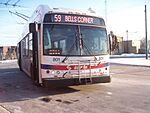 |
Electric trolleybus | 40 ft (12 m) | 2007-2008 | 800-837 (38) | |
| New Flyer DE40LF | 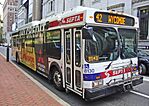 |
Diesel-electric hybrid | 40 ft (12 m) | |||
| 2009 | 8220-8339 (17 units remaining) |
|
||||
| New Flyer DE40LFR | 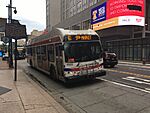 |
40 ft (12 m) | 2010 | 8340-8459 (54 currently in service) |
|
|
| 2011 | 8460-8559 (93 currently in service) |
|
||||
| Nova Bus LFSA HEV | 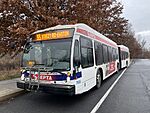 |
62 ft
(18.9 m) |
2013-2016 | 7300-7484 (185) | ||
| Nova Bus LFS HEV | 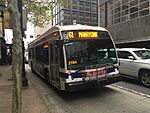 |
40 ft (12 m) | 2014 | 8600-8689 (90) | ||
| New Flyer MiDi | 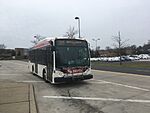 |
Diesel | 30 ft (9.1 m) | 2016 | 4600-4634 (35) | |
| Proterra Catalyst BE40 | 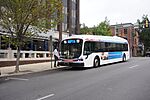 |
Battery-electric | 40 ft (12 m) | 2017 | 900-924 (25) |
|
| New Flyer XDE40 |  |
Diesel-electric hybrid | 40 ft (12 m) | 2016-2017 | 3000-3089 (90) | |
| 2018 | 3090-3194 (105) | |||||
| 2019 | 3195-3294 (100) | |||||
| 2019–2020 | 3295-3409 (115) | |||||
| 2020–2021 | 3410-3524 (115) | |||||
| 2022–2024 | 3525-3744 (220) | |||||
| 2025 | 3745-3864 (120) |
|
Subway
The Broad Street Line uses trains built between 1982 and 1984. These trains are made of stainless steel. Some have driver cabs at both ends, while others have only one.
The Market–Frankford Line uses trains built from 1997 to 1999. These trains are called M-4 cars. In 2017 and 2020, some of these cars needed repairs for cracks in their steel frames.
Trolley
SEPTA has three types of trolleys.
The trolleys on the Subway–Surface lines (Routes 10, 11, 13, 34, and 36) were built starting in 1981. They are called "K-cars" and are 50 feet long. They can go up to 40 miles per hour (64 km/h).
The suburban trolley lines (Routes 101 and 102) use 29 trolleys that are similar but a bit larger. They can go up to 50 miles per hour (80 km/h). Unlike the city trolleys, these can be driven from either end.
SEPTA Route 15 (Girard Avenue Line) uses PCC cars. These trolleys were originally built in 1947 and rebuilt in 2003 to include air conditioning and wheelchair lifts. They are being rebuilt again and will have plastic seats when they return to service.
SEPTA is also ordering 130 new low-floor trolleys from Alstom. These new trolleys are expected to start service between 2027 and 2030. They will be used on the Subway-Surface lines, Route 15, and the suburban trolley lines.
Regional Rail
SEPTA's regional rail services mainly use "Silverliner" electric trains. During busy times, they also use passenger cars pulled by electric locomotives.
Interurban
The Norristown High Speed Line uses a special type of train called N-5s. These 26 trains were delivered in 1993. They are powered by a third rail and can go up to 70 miles per hour (113 km/h).
Accessibility
All of SEPTA's buses are designed to be accessible for people with disabilities. However, only about 46% of its subway and commuter rail stations are accessible. The trolley vehicles are not fully accessible, except for the rebuilt PCCIIIs.
Maintenance Facilities
SEPTA has many places where it maintains its vehicles.
- Transit Divisions
- 69th Street Yard (for the Market–Frankford Line)
- Allegheny Depot (for buses)
- Berridge Shops (for bus maintenance)
- Bridge Street Yard (for the Market–Frankford Line)
- Callowhill Depot (for buses and trolleys)
- Comly Depot (for buses)
- Elmwood Depot (for trolleys)
- Fern Rock Yard (for the Broad Street Line)
- Frankford Depot (for buses and trackless trolleys)
- Frontier Depot (for suburban buses)
- Germantown Brakes Maintenance Facility (for bus brakes)
- Midvale Depot (for buses)
- Southern Depot (for buses)
- Victory Depot (for buses and light rail)
- Woodland Maintenance Facility (for trolley repairs)
- Regional Rail
Connecting Transit Agencies
Local Services
The PATCO Speedline is a train line that goes from Center City Philadelphia to Camden, New Jersey. You can transfer to SEPTA's Market–Frankford Line and Broad Street Line at some stations.
Other local bus services connect with SEPTA. For example, Krapf's Transit runs buses in western Philadelphia suburbs. Pottstown Area Rapid Transit (PART) runs buses in Pottstown and connects with SEPTA Route 93 buses.
Regional Services
NJ Transit runs buses from Philadelphia to various places in New Jersey. It also has train lines that connect with SEPTA's Regional Rail at the Trenton Transit Center.
DART First State provides bus service in Delaware. This service connects with SEPTA's Wilmington/Newark Line trains in Wilmington and Newark, Delaware.
National and International Services
Amtrak provides train service from 30th Street Station in Philadelphia to cities across the U.S. and even to Montreal. Some SEPTA Regional Rail lines share tracks and stations with Amtrak. Amtrak trains are faster but usually more expensive than SEPTA.
Greyhound and other bus companies stop at the Philadelphia Greyhound Terminal. This terminal is close to SEPTA's Jefferson Station and the Market–Frankford Line.
SEPTA also serves Philadelphia International Airport with local bus service and the Airport Line train from Center City.
See also
 In Spanish: Autoridad de Transporte del Sureste de Pensilvania para niños
In Spanish: Autoridad de Transporte del Sureste de Pensilvania para niños
- List of metro systems
- List of United States rapid transit systems by ridership
- Commuter rail in North America
- List of suburban and commuter rail systems
- List of United States commuter rail systems by ridership
- List of light rail transit systems
- List of United States light rail systems by ridership
- List of United States local bus agencies by ridership


